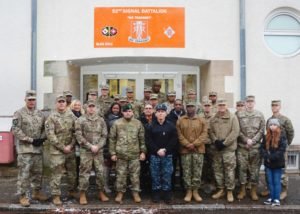[slideshow_deploy id=’42776′]
Story and photos by John Reese
USAG Stuttgart Public Affairs
Barracks dwelling Soldiers of the 52nd Signal Battalion, plus some sister service members, recently took charge of their Patch Barracks quarters from the Installation Management Command-Europe, in a brief ceremony.
“The garrison has officially handed the Army Barracks Management Program over to the units,” said Sgt. 1st Class Anthony Hopkins, Headquarters and Headquarters Company, USAG Stuttgart. “This handover is to the 52nd Sig. Bn.”
This is the first transfer of responsibility for USAG Stuttgart. The ownership of Bldg. 2311 is now under the control of the unaccompanied Soldiers, Sailors, Airmen and Marines who reside within.
“Our garrison team will oversee how the program will continue,” said Command Sgt. Maj. Toesa Tia, senior enlisted adviser, USAG Stuttgart, addressing the junior enlisted residents of Bldg. 2311, and officers and senior NCOs from different services in attendance. “There’s still some kinks to work out, but for the most part, we’re set in stone.”
Tia said the service members were going back to basic fundamentals by managing their own living quarters.
“It’s kind of like owning your battle space, if I can articulate that in a more tactical way,” Tia explained. “That’s what this is all about.”

Since the majority of residents are part of the 52nd Sig. Bn., two special signs in Signal orange were unveiled to give pride in ownership.
“It’s a little more complicated here because we don’t have singular unit control,” said Capt. Robert Ryan, commander, HHC USAG Stuttgart. “Maybe half the barracks is occupied by a specific unit, so that makes it more difficult for one unit to control a specific building.”
Multiple units residing in the same building has challenges for various responsibilities, such as charge of quarters, due to varied schedules and missions of those units. One command will be responsible for the barracks so there’s a “go-to” person is something is not in compliance. The only barracks building in the garrison footprint currently occupied by a single unit is that of the 554th Military Police, Ryan said. The 52nd Signal has a wide variety of military occupational specialties working different schedules.
“USAG Stuttgart is unique with many things of that dynamic and breakdown, plus being a purple community,” Ryan said. “In this barracks, you have 52nd Signal Soldiers, HHC Soldiers, some DISA Soldiers, and one or two others. We also have some Marines, some Airmen and some Sailors that are living there.”
The mix of residents could include Army Reserve and National Guard Soldiers on extended assignments, adding to the complexity. Keeping common areas in order or organizing “GI” parties is another challenge.
According to U.S. Army Europe, units taking control of their barracks will establish inspection programs, train noncommissioned supply officers how to inventory and manage supplies for barracks. The intent of returning control of the barracks to the units is to increase readiness, to maintain the health and welfare of the Soldiers who live there, and to instill pride, esprit and discipline within their formations.
“Here is what ownership means to me. Company-level commanders and first sergeants will own the barracks and therefore must ensure good order and discipline is maintained within their barracks through leadership presence during and after duty hours and on weekends and holidays,” wrote Lt. Gen. Christopher G. Cavoli, commander, USAREUR, in a memorandum dated Aug. 10. “They will own the building and the furniture and the responsibility to provide their Soldiers a quality and safe environment to live and to hold them accountable for damages. As such, company level commanders and 1SGs will ensure their Soldiers maintain the barracks in a clean and orderly manner, conduct facility inspections and furniture inventories, and submit work orders for needed repairs.”
USAREUR and Stuttgart are well-ahead of the ABMP curve; the transfer of Bldg. 2311 met a USAREUR transfer deadline of Dec. 1, while the Army directed the transfer to be completed by the end of July 2019.
